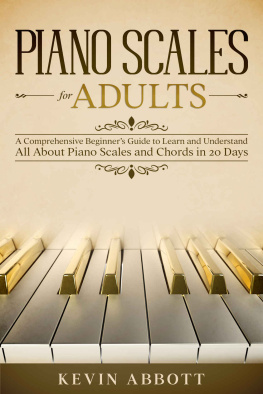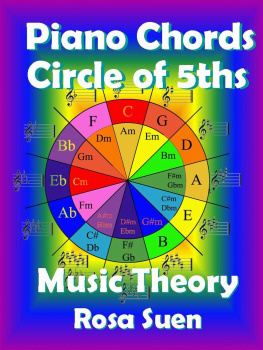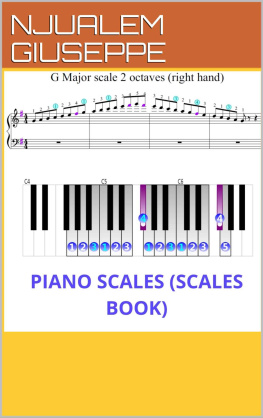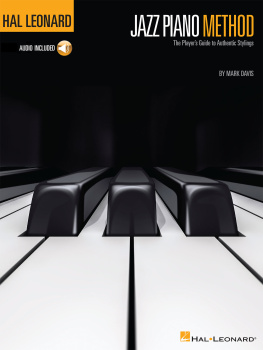Piano Scales for Adults
A Comprehensive Beginners Guide to Learn and Understand All About Piano Scales and Chords in 20 Days
Copyright 2021 - All rights reserved.
You may not reproduce, duplicate, or send the contents of this book without direct written permission from the author.
You cannot hereby despite any circumstance blame the publisher or hold him or her to legal responsibility for any reparation, compensations, or monetary forfeiture owing to the information included herein in any direct or indirect way.
Legal Notice :
This book has copyright protection. You can use the book for personal purposes. You should not distribute, or sell, use or alter, quote and take excerpts, or paraphrase everything or a part of the material contained in this book without obtaining the permission of the author first.
Disclaimer Notice :
You are informed that the information in this document is for casual reading and entertainment purposes only. We have made every attempt to provide accurate, up to date, and reliable information. You are not eligible to warranties of any kind. The readers of this book agree that the writer is not occupied in giving legal, financial, medical, or other advice. The source of this book is from many places. Please consult a licensed professional before you try any techniques shown in this book.
By going through this document, the book-lover comes to an agreement that under no situation is the author accountable for any forfeiture, direct or indirect, which they may incur because of the use of material contained in this document, including, but not limited to, errors, omissions, or inaccuracies.
Introduction
Learning the piano is an incredibly rewarding journey comprising one major step - deciding to learn! You can choose an acoustic piano, a digital piano, or digital keyboards. Keyboards are the most convenient and versatile method, but they do not sound as exciting as the acoustic piano. Digital pianos mimic the tone of the piano, but you will miss out on the feel. Here in this book, "Piano Scales for Adults," we give you all the scales you need to learn the piano.
It is a comprehensive guide to learning all the different scales in different styles, including jazz and blues. By learning the scales, you become an expert in handling the nuances of style and playing riffs effortlessly. This is the first and only step you need to achieve mastery over the piano.
We have included scales from different genres of music. These scales give you the feel of the music and tell you the right way to approach songs in the genre. By practicing the scales, you can accompany songs and play interludes because you know the notes that belong to the scale.
Start on your mystical journey; there is more to it than merely tickling the keyboards. There is a wonderful world of sound and harmony waiting for you. You must discover which door to open and when you do, you will discover the joy of the musical wonderland there. Take the first step now, and you will enter a new world.
Chapter 1: Learn the Notes on the Keyboard
The piano is the magnificent, ageless instrument musicians used to play classical pieces and songs in the Rhythm & Blues, Rock, Pop, Latin, and Jazz genres. For the beginner, the utter simplicity of the layout of the keys presents the biggest challenge.
What should one do to get going? Don't get befuddled at the beginning by thinking about the keys - think about the kind of musician you want to become. If you want to become a jazz musician, you must listen to jazz music and aim to play a piece or two of your favorite music. Many people like classical music and more than half the music written in this genre focuses on the piano as its principal instrument.
Identify the Octave
The basic part of the piano keyboard is the octave. It helps you identify the pattern of the keys. There are bunches of two and three set black keys on a continuous set of white keys. We see 88 keys on any standard piano keyboard. You can also play using 66 keys, and the models having 72 keys allow you to play most of the music written for the piano.
If you go from one note up to its next identical one, you have one octave.

You can break the 88 keys of the piano keyboard into 7 octaves (a full set of 12 semitones). The notes repeat themselves after each octave; only the pitch will increase by a harmonic.
Locate Middle C
You now know how to check for the octave note. Now, you come to the most important task - get the location of the middle C. This key is important because it serves as the tuning key for all musical instruments. In the figure above, you see the layout of the keyboard of an 88-key piano. Before we identify the individual notes, we can see the octaves given in ascending order. The fourth octave has a blue note on it. This note is the middle C. We also refer to it as 4C, meaning the C in the fourth octave of the piano. Its frequency is 262 Hz. The hearing test occurs between C4 (or 4C) and A5, also called A (440). This is A occurring in the next higher octave. As a note of interest, God's frequency is 39.17 Hz. Many people claim it is the frequency at which they had direct communications with God.
Identify Individual Notes
The octave starts with C. This is the note below the first of the two black grouped notes. The lowermost C (1C) is above three notes in the figure above - two white notes and one black note.
The musical scale notes are ABCDEFG, and they repeat, so we get ABCDEFGABCDEFG and so on. These are the natural notes or the white notes on the keyboard. The first note here is A, and the next one is B. The third note is C, the beginning of the first octave. At the finishing end of the keyboard, at the 7th octave, we have a B. This is the note before the starting note of the octave C. There are 88 keys, 7 octaves (7 x 12 = 84), three notes below the first octave, and one-note above the last one (84 + 3 + 1 = 88).
If you want to play C, you must locate the group of two notes and play the note below it. The other notes remain arranged in ascending order of C. The note between the two black notes is D. We have E as the note next to D above the group of two notes. When we take the group of three notes, the lowest note (the notes increase in pitch as we go from left to right, with the highest note at the right extreme point of the keyboard) is F. The two notes in the middle (reading left to right) are G and A. On the right side of the three-note group, we have B. This note is below C.
The Black Keys
The two group notes' lower key is C# (C sharp - the note above C). We can also call it Db (D flat), meaning it is the note below D. The difference between any two notes on the keyboard is a half note. Sometimes the half note is white, and at others, it is black.
Finger Numbering System
It is important to follow a number system because it will help you study fast. For this, we start by assigning the number 1 to the thumb. Both the right and left hands have the number 1, and the numbers increase as we go away from the thumb. The finger next to the thumb gets two (index finger has the number two).
In this manner, the numbers increase until we reach the pinky finger with the number five. By following this system, you can know which finger to use when playing the notes.
Play the Scales
You know the names of the notes and the numbers of the fingers. Start playing the scales. The scale is a compilation of notes from the root note to the octave note. The most used one is the major scale, which is the Ionian mode and has seven notes. You will not see any sharp or flat in the C major scale.












